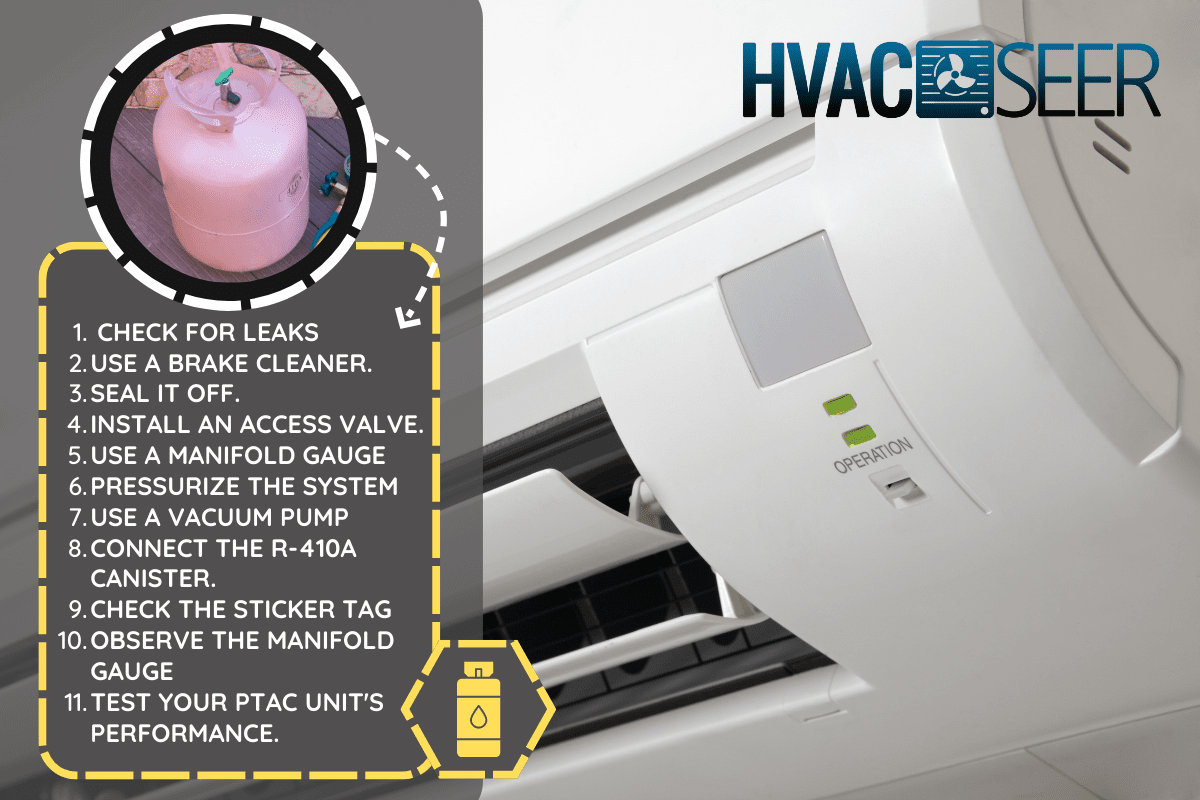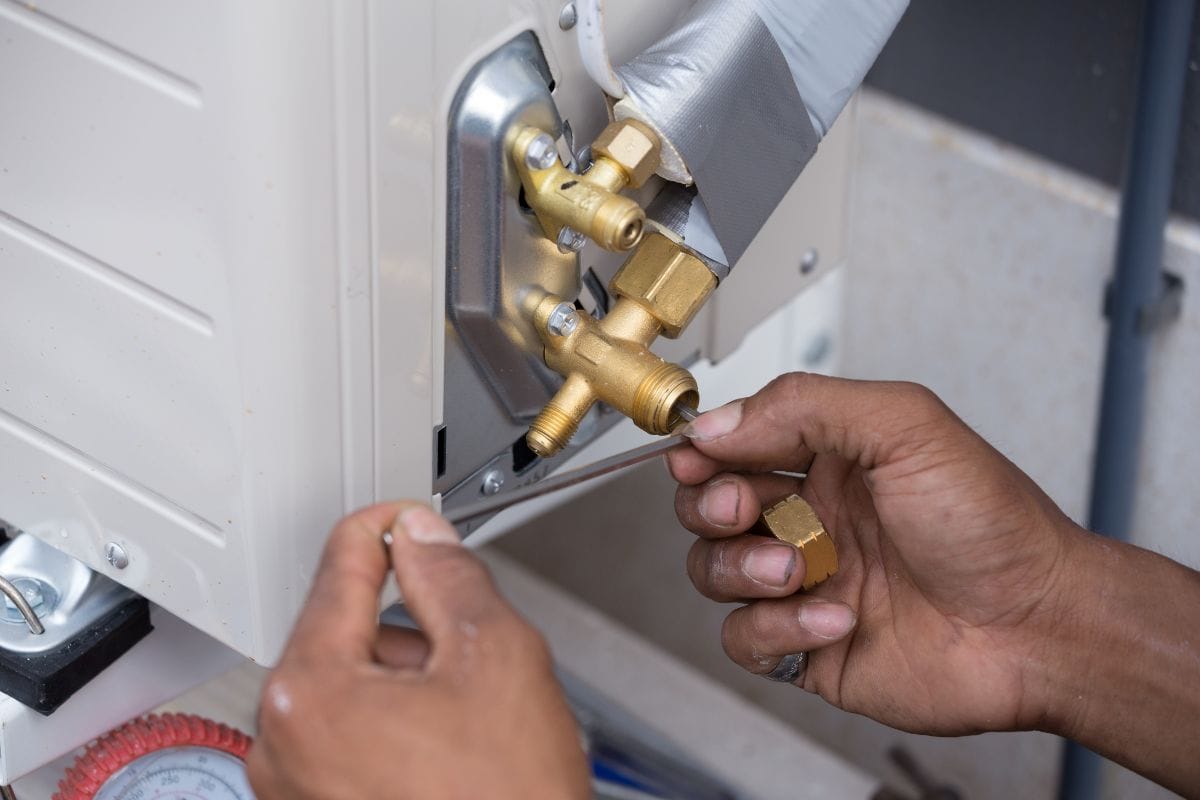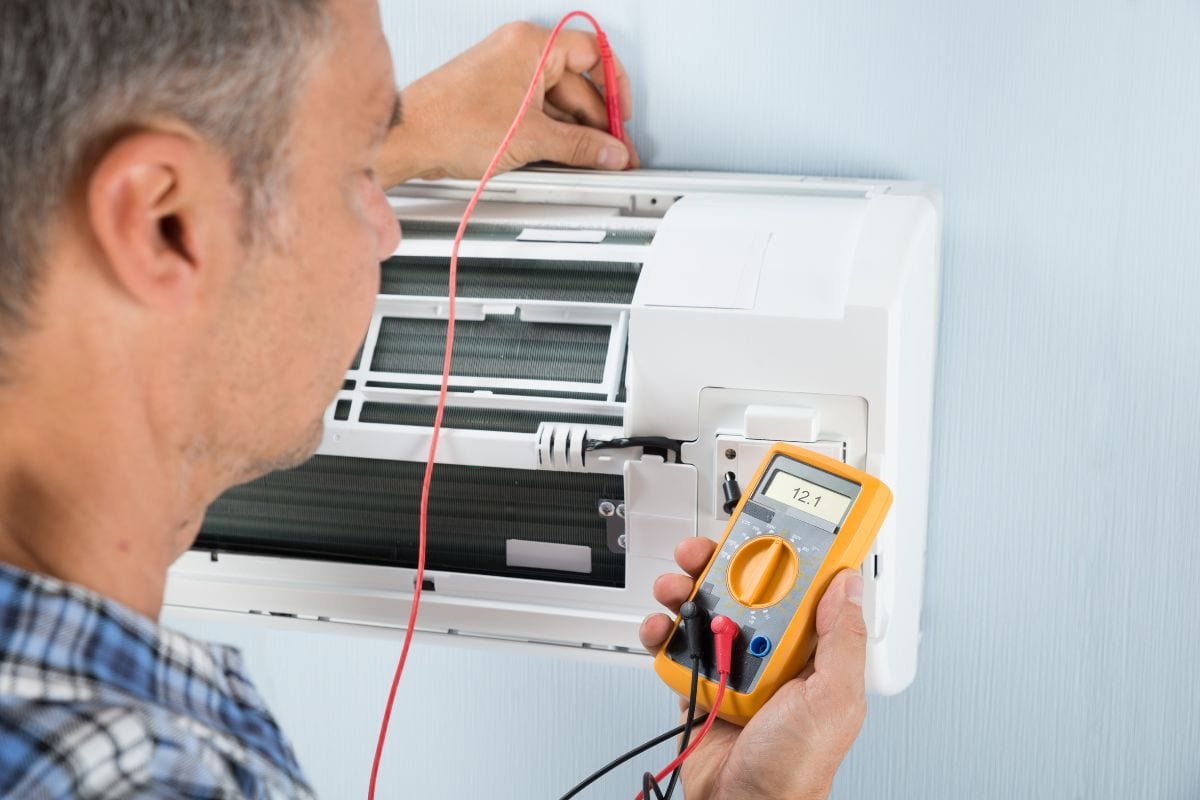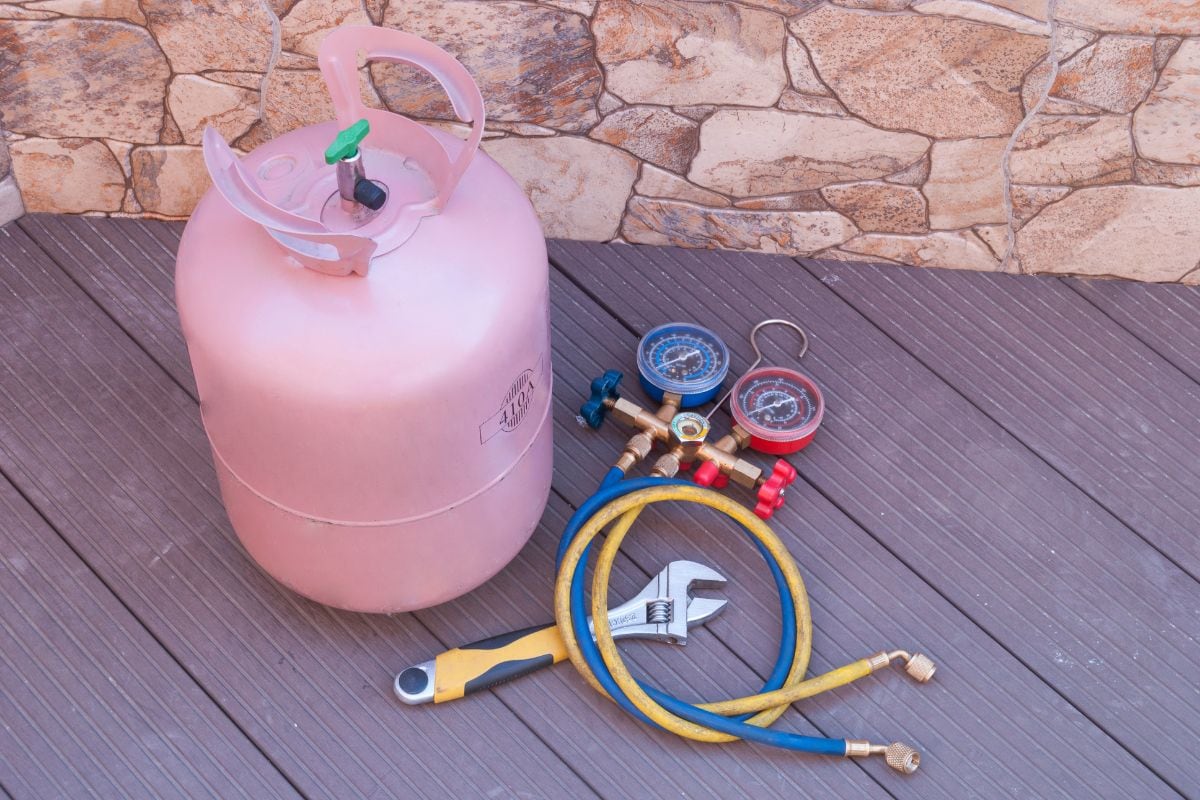Adding freon to a PTAC unit is uncommon since it's expected that the unit should have it. HVAC technicians recharge it only when a refrigerant leak occurs. It's not recommended for non-professionals to tinker with it. But if you want to learn how to do it, we've put together these steps from our research.
To recharge your PTAC unit with freon, these are the steps generally performed from start to finish:
- Check for leaks
- Use a brake cleaner
- Seal it off
- Install an access valve
- Use a manifold gauge
- Pressurize the system
- Use a vacuum pump
- Connect the R-410A canister
- Check the sticker tag
- Observe the manifold gauge
- Test your PTAC unit's performance
When you understand the systematic steps, adding freon to a PTAC unit looks simple. However, it's easier to read about than to actually do it. Attention to detail and proper tools are crucial for a properly running AC and personal safety. Keep reading as we elaborate on the small details in all angles of recharging your PTAC unit.

It All Starts With A Leak
You require special equipment and technical knowledge to add freon to your PTAC unit. To give you a better idea, we advise that you read the steps enumerated and watch this demonstrative video.
1. Check for Leaks
Start by checking the unit to see if there have been any leaks around the refrigerant lines. Ensuring that the system does not have cracks helps you keep the level of refrigerant you're going to add later.
2. Use a Brake Cleaner
Get rid of the excess oil on the surface of the leak (shown as an example in the video is the capillary tube) using a brake cleaner.
Though the standard refrigerant used in PTAC units isn't flammable under ambient conditions, it can still hold fire during brazing. It is therefore vital to remove the residual oil on the leaky part.
3. Seal It Off
Seal off the leak in the refrigerant line by brazing cast iron. You're going to need a welding torch and, of course, cast iron. This is to prevent any additional leaks that would cause your system to lose refrigerant after recharging it.
Preparatory Phase
4. Install an Access Valve

PTAC unit refrigerant lines are tightly manufactured. Furthermore, the pre-charged freon should last your unit's lifetime, save for potential leaking. For this reason, your system lacks an opening through which you can add refrigerant.
There are two ways to create a sealable opening to pour more refrigerant into your PTAC unit:
Using an Access Valve
To install the access valve, you'll need a welding torch to melt the low-side service port and a pair of pliers to clasp the access valve while piercing it through the molten port.
See this AC Access Valve on Amazon.
Using a Bullet Piercing Valve
To install the bullet piercing valve, you first need to clamp the valve onto the low-side service port. Next, crank the piercing pin counter-clockwise with the provided Allen wrench until it punctures the service port.
Although it is easier to use a bullet piercing valve, it's more vulnerable to future leaking.
See this Bullet Piercing Valve on Amazon.
Tap the access or bullet piercing valve on the low side of the system. This opening lets you vacuum the system and recharge the unit with refrigerant.
Be careful not to install the valves on the high side because charging freon there would potentially make it burst from the high pressure. It is always okay to seek assistance in times of doubt.
5. Use a Manifold Gauge

The manifold gauge has two pressure gauges, one red and the other blue. The blue gauge displays low-pressure readings, while the red meter displays high pressure. A manifold body with valves on either end is located below the gauges.
The valves regulate the gas flow to the gauges. Three hose couplings are attached to the bottom of the manifold body.
Using the manifold gauge, plug in the hose of the blue gauge to the access valve. Leave the Schrader valve back on. Next is to connect the manifold's service port to your compressor to prepare for the next step.
Clearing The Refrigerant Lines
6. Pressurize the System
Check for leaks by using an air compressor or a compressor with nitrogen to pressurize the system. Take the service port to the gauges and hook it up to the compressor's air hose.
To connect them, you'll need an adapter. Start pressurizing the system around 80 psi on the blue gauge.
Let it sit for some minutes to ensure you avoid losing any pressure. After a few minutes, you can assess if the system is still holding the pressure.
To double-check whether there are still leaks in the refrigerant lines, you can pour soap bubbles into them. If no additional bubbles are coming out, that's a sign that there aren't any more leaks.
After the system checks out for no leaks, it's time to clear out the refrigerant lines of air.
7. Use a Vacuum Pump

Vacuum out the system by releasing pressure at the blue gauge's valve and connecting the manifold gauge's discharge hose(middle) to the vacuum pump. Running the vacuum pump for 25-30 minutes will ready the system for a recharge.
Adding The Freon
8. Connect the R-410A Canister
Turn the canister upside down and attach it to the service port. Before you begin adding freon, it is important to weigh the refrigerant first to prevent overcharging. You can check how much refrigerant your PTAC unit needs on the sticker tag around the front of the unit.
9. Check the Sticker Tag
Your PTAC unit may display a sticker tag "Refrigerant R-410A (ozs.)" with the quantity specified on its side. Determine how much refrigerant the system uses, and follow the prescription to add freon to the system.
10. Observe the Manifold Gauge
Turning the R-410A canister valve counter-clockwise lets the refrigerant flow to the low side of your system. You may overcharge the refrigerant, but this should not worry you since it is a common problem. The unit's manifold gauge will guide you in determining whether you have added excess freon.
If you overfill the refrigerant, you can purge a little out by loosening and tightening the hose manifold valve until enough pressure is released.
11. Test your PTAC Unit's Performance

Upon adding the freon, you can start testing your PTAC unit by turning it on. Depending on the ambient temperature, it should display between 130-150 in the blue manifold gauge.
The discharge temperature should be at least 16° different from the real-time temperature. Once you see that your unit is running smoothly again, you've successfully recharged your PTAC unit.
What Refrigerant Do PTAC Units Use?
R-410A is widely acknowledged as the most viable alternative for the previously used R-22 for PTAC units. The Montreal Protocol from the early 2000s advocated policies to eradicate ozone-depleting CFCs affecting R-22 and the public standards for freon usage.
Since then, PTAC makers have modified their current models to handle R-410A efficiently.
Does Low Freon Always Mean A Leak?
Leaks in your line are the most frequent cause of low freon levels. The enormous pressure of the system will eventually cause it to seep out if there is even a tiny crack or bend in the refrigerant line. Deterioration of the refrigerant lines may cause these leaks.
There won't be any dripping because refrigerant normally evaporates as it escapes. Instead, you will notice frost forming over the indoor coils as your unit loses refrigerant.
Where Do Most Freon Leaks Occur?

Generally, freon leaks start in the evaporator coil. Since the refrigerant is primarily a superheated gas in the evaporator coil, it can leak through smaller openings. The refrigerant is either liquid or in a gaseous state, depending on where the freon is in the cooling cycle.
Can You Smell Freon?
Inhaling freon in a closed area can be toxic to your health. The chemical is typically an odorless gas, but it can have a sweet fragrance similar to a car coolant.
In Closing
It is best to let an HVAC technician add freon to your AC unit. Accidents from trying to fix your unit on your own might cost you more than hiring someone who can do it. If you still decide to add freon yourself, you will need the right tools and proper safety knowledge.
If you found this article helpful, you might also want to check out these other posts:
How To Add Freon To A Lennox Air Conditioner
Do Central Air Conditioners Use Freon? [And Should You Recharge Them?]


